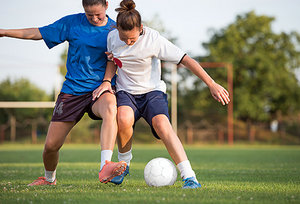Managing Sports Injuries Without NSAIDs / Painkillers
By Mehwash Zafar
As an active person, your favorite sport or exercise is an important part of your life. It gives you energy, it challenges you and it makes you come alive. You can't imagine a day without it until the day you get injured.
Sports injuries are a natural consequence of the choice of being active. Keeping informed on how to manage an injury is just as important as taking precautions to avoid them.
The Standard Protocol for Managing Injuries
The first line of treatment and the standard protocol for managing acute injuries is a method known as RICE, which stands for Rest, Ice, Compression and Elevation.
Rest means reducing physical activity in the injured area, for example, by using a crutch or some other method of taking weight off the injured part of the body. Ice is applied to the area to reduce inflammation to the muscles. Compression refers to compressing the area using any means like an elastic wrap to help reduce swelling, and Elevation refers to raising the area, also to help reduce swelling.
Painkillers Help With Pain, But They Aren't for Everyone
During the course of rehabilitation, doctors sometimes prescribe medication that can relieve pain. Common medications include opioids like morphine and methadone, which, despite their benefits, can lead to addiction and a number of side effects; and nonsteroidal anti-inflammatory drugs (NSAIDs) such as ibuprofen, aspirin and naproxen. NSAIDs reduce swelling and help patients return to activity more rapidly than with the RICE method alone. The way NSAIDs work in the body, however, can be problematic:
- They are contraindicated for patients with a history of gastrointestinal bleeding and must be used cautiously in those with chronic kidney disease.
- Some patients can't tolerate the adverse effects, which may include stomach upset, vomiting and abdominal pain
- Others may have medication interactions that prohibit use of oral NSAIDs.
Two Scientifically Backed Alternatives to NSAIDs/ Painkillers
1. Precut Kinesiology Tape is an option that uses and supports the body's own natural neurology to deliver drug-free pain relief. These tapes work by lifting the skin to create a small space between the muscle and dermis layers of the skin. That extra space takes the pressure off injured muscles, allows muscle movement, and provides space for drainage and blood flow to muscles and joints, thus reducing swelling; while also soothing overworked muscles and strengthening weak or fatigued muscles.
 A recent study conducted at the University of Toronto and published in the Clinical Journal of Sport Medicine found that using precut kinesiology tape was as effective as using NSAIDs for relieving pain and improving function when used alongside physiotherapy for patients with shoulder injuries. In fact, the precut kinesiology tapes were better tolerated than NSAIDs because there weren't any chemical side effects.
A recent study conducted at the University of Toronto and published in the Clinical Journal of Sport Medicine found that using precut kinesiology tape was as effective as using NSAIDs for relieving pain and improving function when used alongside physiotherapy for patients with shoulder injuries. In fact, the precut kinesiology tapes were better tolerated than NSAIDs because there weren't any chemical side effects.
Furthermore, using these precut tapes is convenient because one application of a precut tape lasts several days, which means, unlike medication, there won't be any hassle of retaking or reapplying the treatment every few hours. Additionally, because precut kinesiology tapes are designed keeping in mind human anatomy, you can apply them easily yourself after instruction by a health care professional.
Health care practitioners are increasingly using precut kinesiology tapes as a means to standardize patient care and provide drug-free pain relief option to patients. Professional athletes are turning to kinesiology tape, as it provides a DIY knesiology solution for performance enhancement and pain relief.
2. Chiropractic Care: Millions of people visit chiropractors every year for all kinds of sports injuries, including injuries to their back, neck, arms and legs. In the sports setting, chiropractors work by manipulating joints that are restricted due to muscle injuries. They help to improve joint alignment so the body can heal itself without surgery or medication.
Chiropractic care not only restores function; it also helps prevent future injuries, in addition to providing relief from pain. Research shows chiropractic treatment is safe, effective and helpful in treating sports-injury-related pains and is a great alternative to NSAIDs.
Professional athletes use chiropractic treatments as a regular part of their training. In fact, studies have shown that regularly incorporating chiropractic care enhances athletic performance and lowers the amount of subsequent injuries athletes experience.
Tip: Chiropractic care is complemented by the use of precut kinesiology tape. The two treatments are increasingly used together to provide further relief, hasten recovery and enhance performance.
The possibility of getting injured while being active is not a reason to avoid exercising or playing sports. Injuries are part of the deal and professional athletes and active people know this for a fact. You should stay active and have fun, while striving for prevention and keeping informed on all the options available to you for treatment and management of sports-related injuries.
Mehwash Zafar is a content writer. For questions or comments regarding this article, you can contact her via the SpiderTech Inc..

